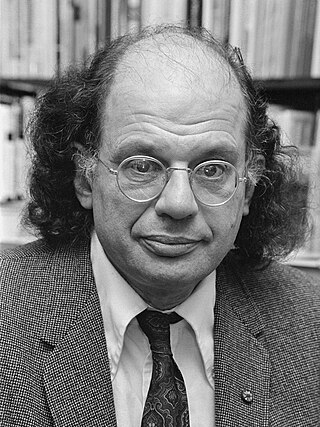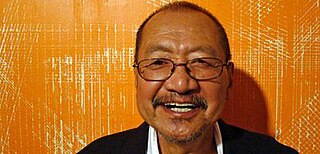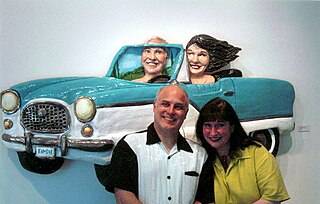Related Research Articles

Irwin Allen Ginsberg was an American poet and writer. As a student at Columbia University in the 1940s, he began friendships with Lucien Carr, William S. Burroughs and Jack Kerouac, forming the core of the Beat Generation. He vigorously opposed militarism, economic materialism, and sexual repression, and he embodied various aspects of this counterculture with his views on drugs, sex, multiculturalism, hostility to bureaucracy, and openness to Eastern religions.

William Carlos Williams was an American poet and physician of Latin American descent closely associated with modernism and imagism. His Spring and All (1923) was written in the wake of T. S. Eliot's The Waste Land (1922). In his five-volume poem Paterson (1946–1958), he took Paterson, New Jersey as "my 'case' to work up. It called for a poetry such as I did not know, it was my duty to discover or make such a context on the 'thought.'" Some of his best known poems, "This Is Just to Say" and "The Red Wheelbarrow", are reflections on the everyday. Other poems reflect the influence of the visual arts. He, in turn, influenced the visual arts; his poem "The Great Figure" inspired the painting I Saw the Figure 5 in Gold by Charles Demuth. Williams won a posthumous Pulitzer Prize for Poetry for Pictures from Brueghel and Other Poems (1962).
Mark Machado, better known as Mister Cartoon or more commonly just Cartoon or Toon, is an American tattoo artist and graffiti artist based in Los Angeles, California. He has been described by the New York Times as an "instrumental figure in the Los Angeles hip-hop scene" and by the BBC as "one of the greatest living tattoo artists in the US". Growing up in the Harbor area of Los Angeles County, young Cartoon began doing illustrations and graffiti then going on to airbrushing clothing and lowrider custom cars. Machado then moved on to working in the music industry doing album covers, tour merchandise and later tattooing recording artists and other celebrities.
Rudolph Carl Gorman was a Native American artist of the Navajo Nation. He was referred to as "the Picasso of American Indian artists" by The New York Times, and his paintings are primarily of Native American women and characterized by fluid forms and vibrant colors, though he also worked in sculpture, ceramics, and stone lithography. He was also an avid lover of cuisine, authoring four cookbooks, called Nudes and Food.

The Six Gallery reading was an important poetry event that took place on Friday, October 7, 1955, at 3119 Fillmore Street in San Francisco.

Don Ed Hardy is an American tattoo artist known for his tattoos, strong influence on the development of modern tattoo styles, and his eponymous apparel and accessories brand.
Wally Bill Hedrick was a seminal American artist in the 1950s California counterculture, gallerist, and educator who came to prominence in the early 1960s. Hedrick's contributions to art include pioneering artworks in psychedelic light art, mechanical kinetic sculpture, junk/assemblage sculpture, Pop Art, and (California) Funk Art. Later in his life, he was a recognized forerunner in Happenings, Conceptual Art, Bad Painting, Neo-Expressionism, and image appropriation. Hedrick was also a key figure in the first important public manifestation of the Beat Generation when he helped to organize the Six Gallery Reading, and created the first artistic denunciation of American foreign policy in Vietnam. Wally Hedrick was known as an “idea artist” long before the label “conceptual art” entered the art world, and experimented with innovative use of language in art, at times resorting to puns.
Better Books was an independent bookstore. It was founded by Tony Godwin and was located at 94 Charing Cross Road, London. The shop was a significant location in the 1960s counterculture movement in London.

Corey Miller is an American tattoo artist and television personality. He began tattooing at the age of 15. He is the owner of a tattoo shop in Upland, California called Six Feet Under. He was one of the core tattoo artists on the reality television show LA Ink.
Nicholas Humberto Hurtado, known as Nikko Hurtado, is an American tattoo artist who specializes in colored portraiture. His signature hyper-realistic color portraits have made him a renowned figure in the tattoo industry with a massive celebrity client list. He has numerous television appearances on shows such as LA Ink, Tattoo Wars, and Ink Master, becoming a judge on Ink Master in 2022. Hurtado is the founder of Black Anchor Collective in Hesperia, California, and Black Anchor Los Angeles in Hollywood, California, both within Black Anchor Worldwide.
Scott Campbell is an American artist and tattoo artist whose clients include Howard Stern, Sting, Robert Downey Jr., Courtney Love, Orlando Bloom, Josh Hartnett, and Marc Jacobs.

Carlos Villa was a Filipino-American visual artist, curator and faculty member in the Painting Department at the San Francisco Art Institute. His work often explored the meaning of cultural diversity and sought to expand awareness of multicultural issues in the arts.

Allan Gorman is a visual art professional born in Brooklyn, New York, best known for his photorealistic paintings of objects within the industrial milieu, spanning from civil engineering structures to sophisticated mechanical devices and vehicles. Gorman's art work has been widely exhibited throughout the United States. He is also a former advertising executive, brand marketing educator, and consultant.
Louis Ginsberg (1895–1976) was an American poet and father of poet Allen Ginsberg.

Benny Alba is an artist who lives in Oakland, California.
Richard Shaw is an American ceramicist and professor known for his trompe-l'œil style. A term often associated with paintings, referring to the illusion that a two-dimensional surface is three-dimensional. In Shaw's work, it refers to his replication of everyday objects in porcelain. He then glazes these components and groups them in unexpected and even jarring combinations. Interested in how objects can reflect a person or identity, Shaw poses questions regarding the relationship between appearances and reality.
F. Lennox Campello is an American artist, art critic, author, art dealer, curator, and visual arts blogger. In 2016 The Washington City Paper called him "one of the most interesting people of Washington, DC."
Jessie Burns Parke, a notable American artist of the Boston School (painting), has become best known for creating the art for the cards in the Builders of the Adytum (B.O.T.A.) tarot card deck. An oil painter and watercolorist, Parke created both easel paintings and miniatures as well as graphics, etchings, and illustrations. She focused on landscapes, nature scenes, and portraits.
Kevin Geary is an English portrait and abstract artist and poet. Some of his works are in the collections of the National Portrait Gallery, London, the Fine Arts Museums of San Francisco, the Abbey Theatre, Dublin, Wigmore Hall and Arundells.

Anthony 'Tony' Natsoulas is an American sculptor and contemporary artist. Numerous galleries and museums such as the San Francisco Museum of Modern Art, the Monterey Museum of Art,, Sonoma Valley Museum of Art, and the San Jose Museum of Art have exhibited Tony Natsoulas' work in the past; there are several large-scale pieces in public spaces.
References
- 1 2 3 4 5 6 7 8 9 10 11 12 Kannapell, Andrea (November 22, 1998). "IN PERSON; His Brush Is a Needle And Skin Is His Canvas". The New York Times. Retrieved April 25, 2021.
- ↑ Profile, HudsonReporter.com. April 3, 2003. Accessed July 31, 2023.
- ↑ Kannapell, Andrea (November 22, 1998). "IN PERSON; His Brush is a Needle and Skin is His Canvas". The New York Times.
- 1 2 3 Allee, Rod (January 14, 2000). "The soul of an artist". The Record. Newspapers.com. Retrieved April 25, 2021.
- 1 2 3 4 5 6 7 8 Hansen, Nate (June 22, 2007). "Self-taught Shotsie lets go after 55 years". Sedona Red Rock News. Retrieved April 25, 2021.
- 1 2 Ruskie, Mark (August 18, 1964). "P.B.A. Nails Midget Title on Gorman's Grand Slam". The Morning Call. p. 14. Retrieved April 25, 2021.
- ↑ "Homer Gives PBA Playoff Tilt, 2-0; Keystone Cops Title", Paterson News.[ when? ]
- 1 2 3 4 5 6 7 8 9 Gogola, Tom (August 2, 2017). "Spotlight on Sonoma". Bohemian. Retrieved April 25, 2021.
- 1 2 3 4 Cowen, Richard (July 8, 1990). ""Making the tattoo respectable" by Richard Cowen". The Record. p. 97. Retrieved April 25, 2021.
- 1 2 "Porchlight: Tattoo Tales". Contemporary Jewish Museum. Retrieved April 25, 2021.
- 1 2 3 Inserro, Allison (April 28, 1991). "Tattoos: Art form of '90s has troubled image". The Herald-News. p. 1. Retrieved April 25, 2021.
- ↑ "Random Shots: That Old Time Religion". Against the Current. October 1990. Retrieved April 25, 2021.
- 1 2 3 Louie, Tim (July 4, 2007). "Shotsie's Tattoo: Wayne, NJ". theaquarian.com. The Aquarian. Retrieved April 25, 2021.
- ↑ Bibby, Patricia Calhoun (January 13, 1991). "Tattoos Declare Independence Of Status Quo". Tulsa World. Retrieved April 25, 2021.
- ↑ Glus, Nina (August 13, 1995). ""Tattoo benefit aids project for homeless," by Nina Glus". The Herald-News. Newspapers.com. p. 11. Retrieved April 25, 2021.
- ↑ "Vision statement". Sonoma Sun. September 17, 2014. Retrieved April 25, 2021.
- ↑ Morris, J. D. (March 20, 2017). "Ugly Tattoo Contest doubles as Planned Parenthood fundraiser". Santa Rosa Press Democrat. Retrieved April 25, 2021.
- ↑ "50 OF THE MOST INNOV". T.A.T. Gallery. Retrieved April 25, 2021.
- ↑ "Near and Far". Bohemian. March 29, 2017. Retrieved April 25, 2021.
- ↑ Gogola, Tom (October 16, 2017). "Inking Recovery". Bohemian. Retrieved April 25, 2021.
- 1 2 3 Williams, Kate (October 22, 2020). "Tattoo you: Sonoma body art gallery back in the ink". Sonoma Index-Tribune. Retrieved April 25, 2021.
- ↑ "Longtime Sonoma Valley tattoo and tarot shop closing, owners looking forward to a fresh start". Sonoma Index-Tribune. 2022-04-28. Retrieved 2023-11-19.
- ↑ "Shotsie Gorman". mercury-tattoo. Retrieved 2023-11-19.
- ↑ Donnelly, Melinda (January 18, 1987). ""Artist helps customers make lasting statements"". The Herald-News. p. 12. Retrieved April 25, 2021.
- ↑ Callahan, Mary (February 27, 2016). "'Tattoos and Blues' returns to Santa Rosa". Santa Rosa Press Democrat. Retrieved April 25, 2021.
- ↑ "Bodies as a canvas: Readers share their tattoos". Sonoma Index-Tribune. February 4, 2019. Retrieved April 25, 2021.
- ↑ "Shotsie Gorman will read and teach poetry". Sedona Red Rock News. August 15, 2007. Retrieved April 26, 2021.
- ↑ Health United States, Family Media, Incorporated, 1984.
- ↑ Clark, Patrick (April 4, 1982). "Women dig in on tattoos". Daily News. p. 648. Retrieved April 25, 2021.
- ↑ Bibby, Patricia (January 11, 1991). "Tattoos get under the skins of many in the mainstream". The Napa Valley Register. p. 27. Retrieved April 25, 2021.
- 1 2 3 4 "Shotsie Gorman". Poets & Writers. 5 June 2009. Retrieved April 25, 2021.
- ↑ "Paterson Literary Review, Issue No. 28, 1999 (1998 Allen Ginsberg Poetry Award Winner Issue)" . Retrieved 25 April 2021.
- ↑ Swanson, Charles (25 April 2018). "April 28: Pure Art in Healdsburg". Bohemian. Retrieved 25 April 2021.
- ↑ "Best Of 2019". Bohemian. March 19, 2019. Retrieved April 25, 2021.
- ↑ Sheridan, Lorna (May 1, 2020). "Sonoma artists bring pop-up installation to Boyes Boulevard". Sonoma Index-Tribune. Retrieved April 25, 2021.
- ↑ "Press the flesh ... and two votes for Willie". The Herald-News. November 4, 1992. p. 4. Retrieved April 25, 2021.